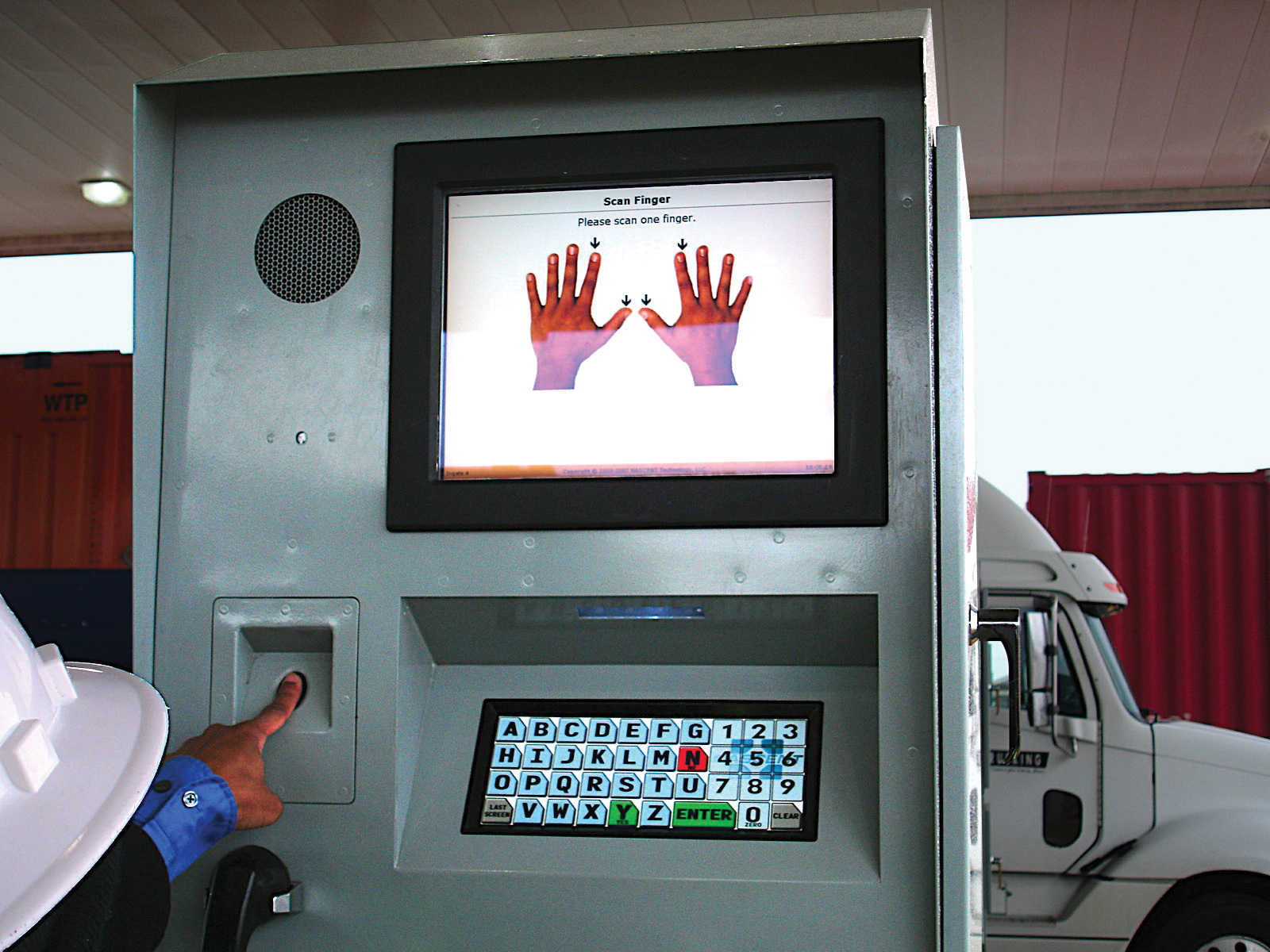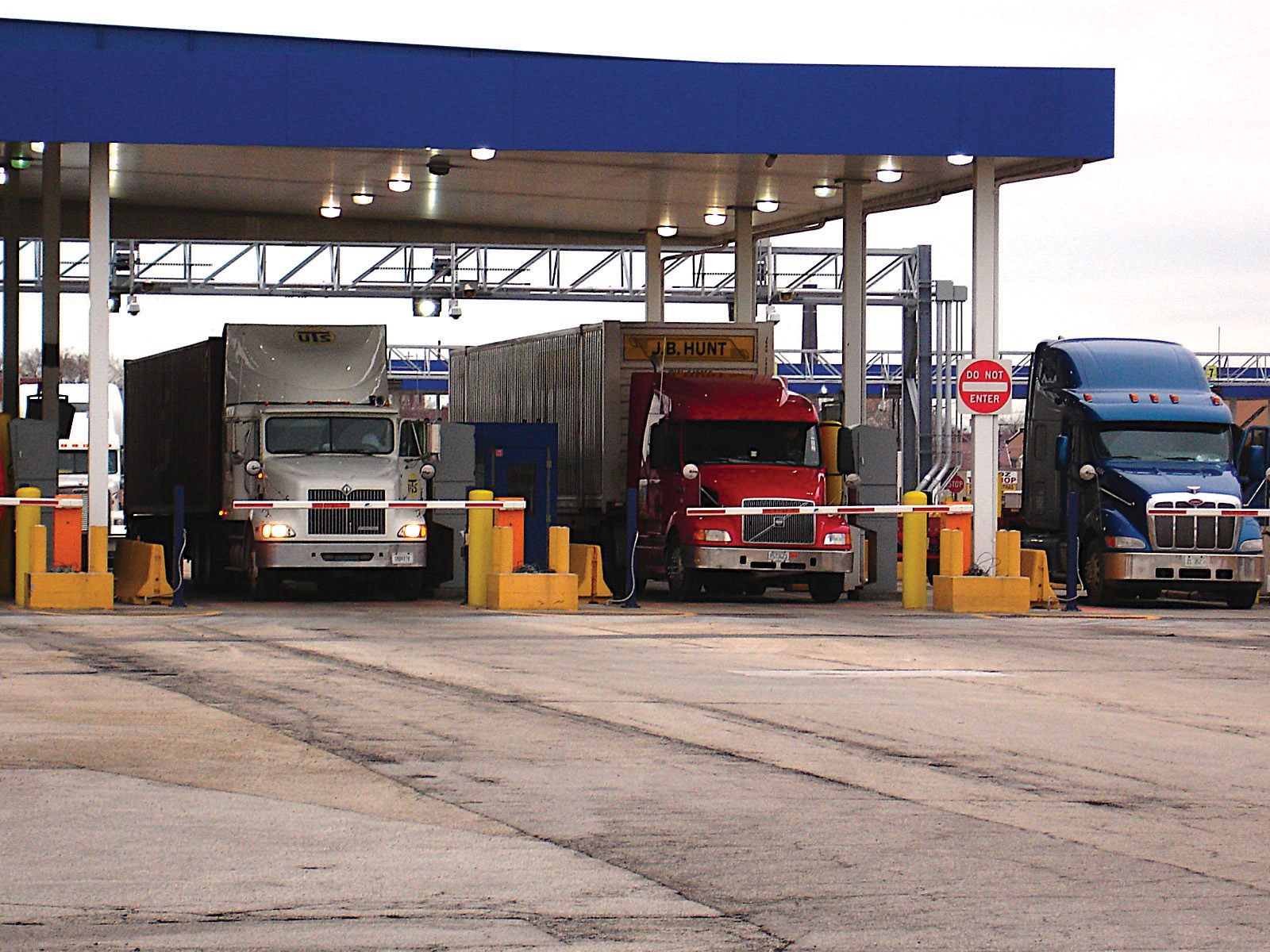By Bill Spence

Truck driver lays finger on biometric sensor in NASCENT verification kiosk at Burlington Northern Santa Fe Railway portal in Chicago, the U.S.A. (Photo by Lumidigm)
Behind-the-scenes baggage handlers, maintenance workers, and other support personnel have access to the tarmac and other sensitive areas of an airport. Indeed, there are millions of personnel supporting the transportation of goods and people around the world. Seaports, airports, railroad and trucking centers -- these transportation hubs are huge and complicated operations that can be difficult to secure. Further, the delays caused by heightened security at transportation facilities are completely unacceptable in an environment where time truly is money and every efficiency can become a competitive advantage.
Biometric systems are increasingly being put to work to bring both greater security and greater profits to the transportation industry. Using biometrics to verify the identities of personnel who have access to sensitive areas and cargo reduces the risk of sabotage, shrinkage, and other security threats. Further, biometric verifications increase the efficiency of massive and intricate transportation hub operations.

Trucks stop at portal for verification process at a Burlington Northern Santa Fe Railway hub in Chicago, the U.S.A. (Photo by Lumidigm)
TRANSPORTATION HUBS
Intermodal transportation involves multiple types of transportation: rail, ship, truck, and plane. These transportation modes intersect at major hubs around the world, transferring cargo and passengers on the way to their final destination. For example, a freight container might be shipped from Rotterdam to the Port of Chicago. There, it is transferred to a short-haul truck that takes it to a railroad hub where it is transferred to a train. It will be taken to another railroad hub where it will be transferred to a truck, and so on. Each of these transfer points -- the ports in Rotterdam and Chicago and the rail yard in Chicago and beyond -- is an intermodal transportation hub.
Operations at a transportation hub are complicated, from both a logistics and a security point of view. Hubs are massive, outdoor operations, measured in acres. Yet, the contents of each freight container must be established, the cargo must be delivered to the correct location by all modes employed, and the identity of the individuals handling the transactions must be verified. Throughout this intricate journey, all transactions must be secure, efficient, and auditable. Biometrics is increasingly being used to enhance operations from all perspectives.
CHICAGO RAIL YARDS
A recent biometric deployment at multiple railroad yards of Chicago, the U.S.A., demonstrates this point. The identity of truck drivers entering and leaving the yards must be verified each time. Adding fingerprint-based biometrics to the truck driver verification process reduced the time the process required, tightened security, reduced errors, and automatically created records of the transaction.
Burlington Northern Santa Fe Railway has two railroad hubs in the Chicago area. They cover a combined area of over 1,000 acres and have 53 truck lanes for entry and exit. The facilities are open 24 hours a day and average 4,000 deliveries every day between them.
When cargo containers arrive at the Port of Chicago, they are put onto semi-trailers driven by short-haul drivers to one of the railroad yards, where they are taken by train to some destination. At the gate, a triple-verification process ensures that the proper container is being delivered by the correct truck and the approved driver. High-resolution photographs are taken of the container to record its condition and identification number. The license plate of the vehicle is captured and recorded.
Finally, the identity of the driver is biometrically verified. The driver must present a valid driver¡¯s license and place his or her finger on a biometric sensor that captures the unique aspects of the fingerprint. The driver is also photographed. The rail yards¡¯ database is queried with the driver¡¯s license number. The query result is the stored fingerprint template associated with that license. That stored template is matched against the live fingerprint information just captured. With the multiple inputs of this two-factor authentication process, the identity of the driver can be verified as well as his or her authority to be driving that truck with that specific cargo container.
The entire process is repeated as trucks leave the hubs carrying containers that have come off the train and are on their way to the Chicago port. In this way, 8,000 driver verifications are biometrically processed at the Chicago rail yards every day. When the verification process was handled by people, it took about five minutes per truck on average, causing long lines and delays. The automated verification system with biometric fingerprint sensors now averages just 90 seconds per transaction. Efficiency has more than tripled and human error has been eliminated. All aspects of the verification process (the truck, the container, the driver) are recorded and traceable. Finally, the security of the hub has been significantly enhanced.
OUTDOOR CHALLENGES
Transportation hubs are large outdoor facilities, creating special challenges for biometrics deployments. Biometrics sensors deployed outdoors must be able to withstand cold, dry conditions as well as dirt and water. In Chicago, the railroad hubs operate in all types of sunlight situations, from bright to cloudy to dark. Further, truck driver¡¯s hands can¡¯t be kept clean by the very nature of their work, and rain and snow are strong features in the Chicago climate.
Multispectral fingerprint sensors from Lumidigm were chosen for the Chicago railroad hubs deployment for two important reasons. Because these sensors use multiple wavelengths of light to read both the external and ¡°internal¡± fingerprints of a person¡¯s finger, they are relatively invulnerable to environmental conditions such as water, dirt, or bright light. Secondly, because the sensors can ¡°see¡± beyond the finger/sensor interface, they require no special finger positioning or pressure. ¡°Our drivers simply drop a finger onto the unit and go on their way,¡± explains James Shondel, Vice President of NASCENT Technology, the creator of the Chicago railroad hubs¡¯ automated verification portal. ¡°The problem with dirty fingers and maintaining performance in all weather conditions was solved with Lumidigm sensors,¡± Shondel adds.
NATIONAL SECURITY MANDATES
operating conditions are not unique to Chicago rail yards. Indeed, when governments set about securing outdoor ports of entry, operational requirements of biometrics solutions are a necessary consideration.
In the United States, the Transportation Security Administration (TSA) is implementing a program that requires a fingerprint-based biometric credential for all seaport workers, including longshoremen, truck drivers, vendors, facility/vessel employees, maintenance personnel, and train crews. The Transportation Worker Identification Credential (TWIC) supports three-factor authentication: the credential (something you have), the biometric (something you are), and a PIN number (something you know).
Intended for identity security threat assessment by the Federal Bureau of Investigation (FBI) and for identity authentication by the Coast Guard, the TWIC program faces the high hurdle of maintaining top biometric performance in the extreme environmental conditions of the seaports. Salt water, rainy and snowy weather, light reflected off the water, chapped fingers -- all require care in selecting biometric components.
The impending TWIC program was a major consideration when a biometric sensor was being selected for the Chicago rail yards. ¡°Since the TWIC rollout includes fingerprint biometrics as part of the verification process, it was important for us to get this critical technology component added to the driver¡¯s license verification process,¡± said Shondel. He continued, ¡°We implemented this biometric portion of our automated gate system just in time for one of the harshest winters in Chicago history, yet we had no problems. As we tell our peers in the TSA, we¡¯re already testing biometrics for you¡¦ and there is no question, this one works.¡± Over a million port workers in the United States will be issued a TWIC card by April 2009. Walter Hamilton, Chairman of the International Biometric Industry Association, says the TSA is running TWIC reader pilots at selected ports to evaluate various biometric sensors and card readers under different environmental conditions. ¡°Biometric performance, particularly in the outdoor environment, was a major concern of both the maritime industry and government. Happily, the biometric industry has stepped up to the challenge and now offers new technologies that can meet the throughput and reliability requirements in this harsh environment,¡± said Hamilton.
SMART CARDS
The TWIC solution calls for ¡°smart card¡± technology, where the seaport worker¡¯s biometric template is stored on the credential itself. The smart card supports off-line biometric authentication, heightening the flexibility of the massive system. Such a scheme has been used successfully for several years at the Port of Rotterdam in the Netherlands, Europe¡¯s largest seaport. Rotterdam¡¯s biometrically enhanced CargoCard is issued to authorized truck drivers who access the seaport. Instead of querying a database for a biometric template, as at the Chicago rail yards, the truck driver¡¯s biometric is captured and compared against the template stored on the CargoCard. If there is a match, the truck driver is admitted. One clear advantage of the biometric smart card is that the credential cannot be transferred to other people. Rotterdam¡¯s authentication system requires the biometric and the credential to match each other -- a highly secure biometric solution.
Biometrics is being widely adopted in the transportation industry, in large part because of the operational efficiencies that biometrics brings to large and complicated transportation operations. Additionally, the use of biometrics to enhance security is being mandated by governments worldwide as they seek to secure vulnerable ports of entry. With careful evaluation and deployment, biometrics can serve both masters, even in the difficult environmental conditions of transportation hubs.

Bill Spence is Vice President of Transaction Systems, Lumidigm, Inc. (www.lumidigm.com)
For more information, please send your e-mails to swm@infothe.com.
¨Ï2007 www.SecurityWorldMag.com. All rights reserved. |



